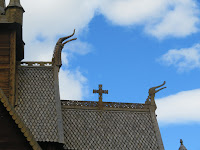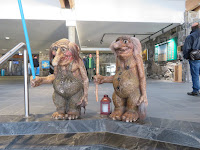 As we headed back down the western coast of Norway, we
managed to cross the Arctic Circle again – just this time we were heading
south. There was a much hoopla as when we crossed in Finland, but there still
was a visitor center and some monuments. We enjoyed our visit.
As we headed back down the western coast of Norway, we
managed to cross the Arctic Circle again – just this time we were heading
south. There was a much hoopla as when we crossed in Finland, but there still
was a visitor center and some monuments. We enjoyed our visit. We began our trek out toward the Geiringer Fjord and the
town of Geiranger. On the way we stopped in the ancient village of Lom for a
lunch break and to take in the sights. Lom is the location of one of the oldest
stave churches (or Stavkyrkje in Norwegian) in Norway, built in 1160.
We began our trek out toward the Geiringer Fjord and the
town of Geiranger. On the way we stopped in the ancient village of Lom for a
lunch break and to take in the sights. Lom is the location of one of the oldest
stave churches (or Stavkyrkje in Norwegian) in Norway, built in 1160.  We wandered all around it and eventually made our way
inside. Because it was built while the Vikings still occupied settlements in
Norway, the decoration on the church had very distinctive Viking symbolism. The
dragons on the church peaks were one of many such pagan symbols to adorn the
church.
We wandered all around it and eventually made our way
inside. Because it was built while the Vikings still occupied settlements in
Norway, the decoration on the church had very distinctive Viking symbolism. The
dragons on the church peaks were one of many such pagan symbols to adorn the
church. As we got a little near Geiranger we wanted to drive up
Dalsnibba, a mountain at the end of the Geiranger fjord valley. Both our guide
and driver had warned us that visibility conditions at the overlook some 4,500
feet above the fjord were often obscured at best. In fact, as we approached the
turnoff to head up to Dalsnibba, our guide announced that it was totally socked
in, and we would skip it for now, and try to go there on our way back out from
Geiranger.
As we got a little near Geiranger we wanted to drive up
Dalsnibba, a mountain at the end of the Geiranger fjord valley. Both our guide
and driver had warned us that visibility conditions at the overlook some 4,500
feet above the fjord were often obscured at best. In fact, as we approached the
turnoff to head up to Dalsnibba, our guide announced that it was totally socked
in, and we would skip it for now, and try to go there on our way back out from
Geiranger. We stopped at the turnoff and our driver made some cell
phone calls to other drivers he knew were in the area. He was told there was
some clearing at the top, and that it might be worth a visit now. So, we got
everyone on board the bus and headed up.
We stopped at the turnoff and our driver made some cell
phone calls to other drivers he knew were in the area. He was told there was
some clearing at the top, and that it might be worth a visit now. So, we got
everyone on board the bus and headed up. By the time we arrived, not only was there some clearing,
but the clouds had simply vanished, both above and below us. We could see
nearly all the Geiranger Fjord, the town, and all the surrounding valley without
any obstacles at all. Both our guide and the driver said in all their years
working in Norway, they had never, ever seen conditions at Dalsnibba so nice.
Keeping our fingers crossed that the weather luck continues.
By the time we arrived, not only was there some clearing,
but the clouds had simply vanished, both above and below us. We could see
nearly all the Geiranger Fjord, the town, and all the surrounding valley without
any obstacles at all. Both our guide and the driver said in all their years
working in Norway, they had never, ever seen conditions at Dalsnibba so nice.
Keeping our fingers crossed that the weather luck continues.
Geiranger was awesome! Not only was there a couple of cruise
ships here ever day, but the fjord is spectacular. We went on a cruise of the
fjord one afternoon, and experienced waterfall after waterfall. Each one was
more spectacular than the previous. The wildlife, both in the water and on the
valley walls, was just fun to see.
 One day we drove the length of the fjord, caught a ferry,
and continued on to the Trolls Road, or Trollstigen in Norwegian. Opened in
1936 after 8 years of construction, it connects the towns of Andalsnes and
Rauma. It soon became a tourist attraction because of its steep incline of over
10% and its 11 hairpin turns up a steep mountainside. How our bus driver
managed this 40-foot beast on that road I will never know.
One day we drove the length of the fjord, caught a ferry,
and continued on to the Trolls Road, or Trollstigen in Norwegian. Opened in
1936 after 8 years of construction, it connects the towns of Andalsnes and
Rauma. It soon became a tourist attraction because of its steep incline of over
10% and its 11 hairpin turns up a steep mountainside. How our bus driver
managed this 40-foot beast on that road I will never know. Now heading to cosmopolitan Oslo, we stopped in the quaint
town of Lillehammer. This area was very much the inspiration for Edvard Grieg
in his musical rendition for “Peer Gynt”. The 1994 Winter Olympics were held
here, and we made a stop to see the infamous ski jumping facility. In the
summer time, locals use the base of the ski jumps as a water and recreation
area.
Now heading to cosmopolitan Oslo, we stopped in the quaint
town of Lillehammer. This area was very much the inspiration for Edvard Grieg
in his musical rendition for “Peer Gynt”. The 1994 Winter Olympics were held
here, and we made a stop to see the infamous ski jumping facility. In the
summer time, locals use the base of the ski jumps as a water and recreation
area. Norwegians love trolls. The love of Trolls actually dates
back to the days of the Vikings. The word Troll came from the Germanic Trullan
which means fiend, demon or giant. Generally, Trolls were considered dangerous
to human beings. Trolls were said to dwell in isolated mountains, rocks and
caves, but were sometimes also considered friendly or helpful. One common belief
was that Trolls could not be exposed to sunlight – if they did, they would turn
to stone. That was the explanation early residents had for the stony hillsides
all over Norway – unwary Trolls. We saw them everywhere!
Norwegians love trolls. The love of Trolls actually dates
back to the days of the Vikings. The word Troll came from the Germanic Trullan
which means fiend, demon or giant. Generally, Trolls were considered dangerous
to human beings. Trolls were said to dwell in isolated mountains, rocks and
caves, but were sometimes also considered friendly or helpful. One common belief
was that Trolls could not be exposed to sunlight – if they did, they would turn
to stone. That was the explanation early residents had for the stony hillsides
all over Norway – unwary Trolls. We saw them everywhere!
The ancient port town of Bergen was a stalwart part of the Hanseatic
League. Founded in 1070, its access to the North Sea made it a central trading
port on the Scandinavian peninsula.
 While the feel of Bergen was similar in
many ways to that of Amsterdam with its canals, the buildings that lined the
water in Bergen were not the luxury residences we saw in Amsterdam. Rather, they
were water side warehouses built to unload and store the myriad goods coming
into this active port.
While the feel of Bergen was similar in
many ways to that of Amsterdam with its canals, the buildings that lined the
water in Bergen were not the luxury residences we saw in Amsterdam. Rather, they
were water side warehouses built to unload and store the myriad goods coming
into this active port.
Bergen was one of the first members of the Hanseatic League,
the trade group founded in Germany the protected the trade routes and
diplomatic privileges of member cities from the 14th to the 17th
centuries.
 While the feel of Bergen was similar in
many ways to that of Amsterdam with its canals, the buildings that lined the
water in Bergen were not the luxury residences we saw in Amsterdam. Rather, they
were water side warehouses built to unload and store the myriad goods coming
into this active port.
While the feel of Bergen was similar in
many ways to that of Amsterdam with its canals, the buildings that lined the
water in Bergen were not the luxury residences we saw in Amsterdam. Rather, they
were water side warehouses built to unload and store the myriad goods coming
into this active port.
Tomorrow we head back into Denmark to begin to finish our
exploration of the Nordic cultures.
Talk to you soon.


No comments:
Post a Comment